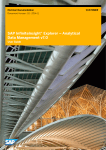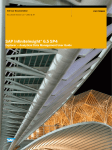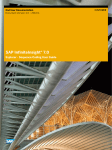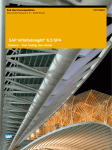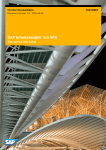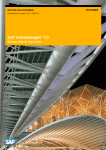Download User Guide
Transcript
End User Documentation
Document Version: 1.0 - 2014-11
SAP InfiniteInsight® 7.0
Data Toolkit User Guide
CUSTOMER
Table of Contents
1
About this Document .....................................................................................................................................3
2
2.1
2.2
Common Steps .............................................................................................................................................. 4
Selecting a Data Set.................................................................................................................................................4
2.1.1
Special Case: Data Stored in Databases - the Explain Mode...............................................................5
2.1.2
Sub-sampling a Data Set ........................................................................................................................6
Describing the Data Set...........................................................................................................................................7
3
3.1
3.2
Data Viewer .....................................................................................................................................................9
Visualizing a Data Set ............................................................................................................................................10
Deleting a Data Set .................................................................................................................................................11
4
4.1
Data Transfer ................................................................................................................................................ 12
Transferring a Data Manipulation ......................................................................................................................... 13
4.1.1
Mapping Fields ....................................................................................................................................... 14
Selecting Variables ................................................................................................................................................ 14
Saving the New Data Set ....................................................................................................................................... 15
4.3.1
Defining Text File Settings .................................................................................................................... 15
4.2
4.3
5
5.1
5.2
List Distinct Values ...................................................................................................................................... 17
Selecting the Variable to Extract .......................................................................................................................... 18
Saving the Categories............................................................................................................................................ 18
6
6.1
Descriptive Statistics.................................................................................................................................. 20
From the Start Panel............................................................................................................................................. 20
6.1.1
Selecting the Variables ......................................................................................................................... 21
6.1.2
Checking the Parameters .................................................................................................................... 24
6.1.3
Generating the Statistics ..................................................................................................................... 28
6.1.4
Statistics Debriefing ............................................................................................................................. 28
From the Panel "View Data" ................................................................................................................................. 29
6.2.1
Computing the Statistics ..................................................................................................................... 30
6.2.2
Viewing the Statistics ............................................................................................................................ 31
Geo-location .......................................................................................................................................................... 32
6.3.1
Using Geolocation Feature .................................................................................................................. 33
6.2
6.3
ii
CUSTOMER
© 2014 SAP SE or an SAP affiliate company. All rights reserved-
SAP InfiniteInsight® 7.0
About this Document
1 About this Document
This document presents the InfiniteInsight® Toolkit provided in SAP InfiniteInsight®.
The features offered in this toolkit allow you to:
explore and delete data sets (Open the Data Viewer).
transfer a data source to another location or format (Perform a Data Transfer).
export the list of distinct values of a variable from your data set. Among other things, this feature allows
you to generate a list of unique index values from an existing data set and to use it as a reference table
when performing an event log aggregation or a sequence analysis in InfiniteInsight® Explorer (List Distinct
Values in a Data Set).
generate variables statistics for a data set, such as the cross-statistics or the profit curves when a
variable in the data set is used to estimate the target variable (Get Descriptive Statistics for a Data Set).
Before reading this document you should be familiar with the section Essential Concepts of the InfiniteInsight® User Guide.
3
CUSTOMER
© 2014 SAP SE or an SAP affiliate company. All rights reserved-
SAP InfiniteInsight® 7.0
About this Document
2 Common Steps
This section of the document describes:
the data source selection,
the data description
which are steps common to several of the Toolkit features.
IN
THIS
C HA P T E R
Selecting a Data Set ............................................................................................................................................... 4
Describing the Data Set.......................................................................................................................................... 7
2.1 Selecting a Data Set
To Select a Data Set
1
In the list Data Type, select the data set file type.
2
Use the Browse button located on the right of the Folder field to select the folder or database containing
the data set.
3
Use the Browse button located on the right of the Data Set field to select the data set file or table.
4
Click the Next button.
If the data source is stored in a Oracle, Teradata or SQL Server 2005 data base, an additional warning may
be displayed, asking you to validate the execution of the query. For more information, refer to chapter
Special Case: Data Stored in Databases (on page 5).
4
CUSTOMER
© 2014 SAP SE or an SAP affiliate company. All rights reserved-
SAP InfiniteInsight® 7.0
Common Steps
2.1.1 Special Case: Data Stored in Databases - the Explain
Mode
Before requesting data stored in a Teradata(1), Oracle(2) or SQLServer 2005 database, SAP InfiniteInsight® uses
a feature, called the Explain mode, which categorizes the performances of SQL queries in several classes
defined by the user. In order to be as fast and as light as possible, this categorization is done without actually
executing the full SQL query.
Note
(1) For all versions of Teradata.
(2) For all versions above and including Oracle 10.
The objective is to allow you to estimate the workload of the SQL query before executing it and then deciding
--possibly thanks to an IT Corporate Policy-- if the SQL query can actually be used.
For example, an IT Corporate Policy may favor interactivity and then define 3 classes of SQL queries, each with
its maximum time:
Immediate: duration < 1 s. The query is accepted and executed immediately.
Batched: 1s <= duration < 2 s. The query is accepted but will be executed on next idle time.
Rejected: 2s <= duration. The query will never be executed.
The number, names and limits of classes are defined by the user in order for these values to match the current
DBMS configuration and DBMS usage policy.
The Explain Mode has been ConfiguredIf the Explain mode has been
configured by your DBMS administrator, there are two possible
outcomes to a query:
the query is accepted and executed: this is completely transparent. SAP InfiniteInsight® accesses the data
without further input from the user.
the query needs to be validated before being executed: a pop-up window opens displaying a message
configured by the DBMS administrator. A query that needs validation can be categorized in two ways:
medium-sized
You will probably have to check with your administrator to know which action to take:
If the administrator authorizes the query, click the Continue button. The pop-up window closes and the
requested action is carried out.
If the administrator does not authorize the query, click the button Stop Query, the pop-up window closes,
but no action is executed.
5
huge
It means that the query will take too much time and resources. In that case, the behavior of the
Continue button depends on the configuration set by the DBMS Administrator (for example, it can
automatically refuse queries that are considered too heavy). In any case, you should check with them
to know the line of action to follow.
CUSTOMER
© 2014 SAP SE or an SAP affiliate company. All rights reserved-
SAP InfiniteInsight® 7.0
Common Steps
The Explain Mode has not been Configured [#]
If your DBMS Administrator has not configured the Explain mode, the following pop-up opens when you try to
access the data:
You need to contact your Administrator who will tell you which action to take and configure the Explain mode.
If the Administrator validates the execution of the query, you may want all queries with the same duration to
be executed without validation. In that case, check the box Do not request validation anymore for similar
requests. The validation message will then only appear for larger queries. This configuration will only be used
for the current session, when closing SAP InfiniteInsight®, it will be lost. For a permanent configuration, see
your DBMS Administrator, who will find the necessary information in the support document Explain Mode
available in section Support and Integration Documentation of SAP InfiniteInsight® documentation.
2.1.2 Sub-sampling a Data Set
Sub-sampling can be achieved by:
selecting a specific first line and last line from the original data,
randomly selecting a proportion of the original data. A random seed can be used to select the same
records from the original data when sub-sampling,
mixing the selection by line and the random selection.
To Define the Sub-sampling Settings
Click the button
(Advanced Settings) located on the right of the field Data Set. A pop-up window
opens, allowing you to set the sub-sampling parameters.
6
CUSTOMER
© 2014 SAP SE or an SAP affiliate company. All rights reserved-
SAP InfiniteInsight® 7.0
Common Steps
To Set a Line Selection
1
Check the option Line Selection in the section Define Sub-sampling.
2
In the field First Line, enter the number of the line you want your sub-sampled data set to begin with.
3
In the field Last Line, enter the number of the line you want your sub-sampled data set to end with.
To Set a Random Sub-sampling
4
Check the option Random Selection in the section Define Sub-sampling.
5
In the section Random Selection, use the Proportion slide to select the percentage of the original data set
you want to keep.
6
In the field Random Seed, enter a seed value for the sub-sampling. This step is optional.
7
Use the Proportion slide to select the percentage of the original data set you want to keep.
2.2 Describing the Data Set
To describe your data, you can:
Either use an existing description file, that is, taken from your information system or saved from a
previous use of SAP InfiniteInsight® features,
Or create a description file using the Analyze option, available to you in InfiniteInsight® modeling assistant.
In this case, it is important that you validate the description file obtained. You can save this file for later
re-use. If you name the description file KxDoc_<SourceFileName>, it will be automatically loaded when
clicking the Analyze button.
Important - The description file obtained using the Analyze option results from the analysis of the first 100 lines of the initial
data file. In order to avoid all bias, we encourage you to mix up your data set before performing this analysis.
For more information on data set description, see InfiniteInsight® - User Guide.
To Load a Description File
1
7
On the screen Data Description, click the button Open Description. The following window opens:
CUSTOMER
© 2014 SAP SE or an SAP affiliate company. All rights reserved-
SAP InfiniteInsight® 7.0
Common Steps
2
In the window Load a Description, select the type of your description file.
3
In the Folder field, select the folder where the description file is located with the Browse button.
Note
The folder selected by default is the same as the one you selected on the screen Data to be Modeled.
1
In the Description field, select the file containing the data set description with the Browse button.
Caution
When the space used for model training contains a physical variable named KxIndex, it is not possible
to use a description file without any key for the described space.
When the space used for model training does not contain a physical variable named KxIndex, it is not
possible to use a description file including a description about a KxIndex variable since it does not exist
in current space.
1
Click the OK button. The window Load a Description closes and the description is displayed on the screen
Data Description.
2
Click the Next button.
8
CUSTOMER
© 2014 SAP SE or an SAP affiliate company. All rights reserved-
SAP InfiniteInsight® 7.0
Common Steps
3 Data Viewer
The Data Viewer allows you to visualize existing data sets and if needed to delete them.
To Display the Data Sets List
1
On the Start panel, click the feature Open the Data Viewer in the section Toolkit.
The panel allowing you to select the location where your data sets are stored is displayed.
9
CUSTOMER
© 2014 SAP SE or an SAP affiliate company. All rights reserved-
SAP InfiniteInsight® 7.0
Data Viewer
2
In the list Data Type, select the type of storage the data sets you want to browse are located in (Text File,
Database, ...).
3
Use the Browse button located on the left of the Folder field to select the folder (or database) containing
the data sets. If you want to explore data sets stored in a password protected database, do not forget to
provide the user name and password granting you access to the database.
The data sets list is displayed in the field Data Sets.
IN
THIS
C HA P T E R
Visualizing a Data Set ........................................................................................................................................... 10
Deleting a Data Set ............................................................................................................................................... 11
3.1 Visualizing a Data Set
To Visualize a Data Set
1
Click the data set you want to visualize. The button View Data at the bottom of the panel becomes active.
2
Click the button View Data. The first hundred lines in the data set are displayed in a new window.
10
CUSTOMER
© 2014 SAP SE or an SAP affiliate company. All rights reserved-
SAP InfiniteInsight® 7.0
Data Viewer
To Select the Number of Lines to Display
3
In the field First Row Index, enter the index of the line before the first one you want to display (for example,
to start on line 1, enter 0).
4
In the field Last Row Index, enter the index of the line before the last one you want to display (for example,
to end on line 100, enter 99).
5
Click the Refresh button to display the selected lines.
To Search for a Variable
6
Click the Search button (Magnifier icon). The window Search Variable by opens.
7
Select the type of search you want to perform (by index or by name). A variable index is its column
number in the data set.
8
In the displayed drop-down list, select the variable index or name.
9
Click the OK button. The searched variable column appears highlighted in the window KXEN Sample Data
View.
To Display the Variables Statistics for the First Data Set Lines
10 In the field Number of Lines, select the number of lines for which you want to see the statistics. To display
the statistics for the whole data set, enter a number below 1.
11 Click the Statistics button (graph icon). The window Statistics for "<DataSetName>" on the first <n> Lines
opens. For more details on statistics, refer to section Descriptive Statisctics > From the Panel View Data
(see "From the Panel "View Data"" on page 29).
3.2 Deleting a Data Set
To Delete a Data Set
1
Select the data set you want to delete. The button Delete Selected becomes active.
2
Click the button Delete Selected. A dialog box is displayed asking you to confirm the deletion.
3
Click the Yes button. The data set is deleted.
11
CUSTOMER
© 2014 SAP SE or an SAP affiliate company. All rights reserved-
SAP InfiniteInsight® 7.0
Data Viewer
4 Data Transfer
The component Data Transfer allows you to transfer a data source to another location or format.
To Start a Data Transfer
1
On the Start panel, click the option Perform a Data Transfer in the Toolkit section.
2
Select the data set you want to transfer (see Selecting a Data Set (see "Selecting a Data Set [#T]" on page
4)).
The panel allowing you to select the data set you want to transfer is displayed.
If you want to transfer an analytical data set, a message box will be displayed after clicking the Next
button, asking you whether you want to transfer the data contained in the analytical data set or if you want
to transfer only its definition.
12
If you choose to transfer the data, the data transfer component will act as if it was a classical data set,
and ask you to describe the data (see "Descriptive Statistics" on page 20) and to save the new data
set (see "Saving the New Data Set" on page 15).
If you choose to transfer only the analytical data set definition, the panel Data Manipulation Transfer
will be displayed (see Transferring an Analytical Data Set (see "Transferring a Data Manipulation" on
page 13)).
CUSTOMER
© 2014 SAP SE or an SAP affiliate company. All rights reserved-
SAP InfiniteInsight® 7.0
Data Transfer
IN
THIS
C HA P T E R
Transferring a Data Manipulation.......................................................................................................................... 13
Selecting Variables ............................................................................................................................................... 14
Saving the New Data Set...................................................................................................................................... 15
4.1 Transferring a Data Manipulation
When transferring a data manipulation, the panel Data Manipulation Transfer allows you to select the target
database, to define the mapping between the source tables and the target tables and, if needed, to define the
mapping between the table fields.
To Define a Transfer
1
To select the target database (that is, the database in which you want to transfer the definition of the
analytical data set), click the Browse button, then select a database in the displayed dialog box. Click the
OK button to validate your selection.
2
In the field Transfer as, enter the name you want the analytical data set to be identified by.
3
Click the Guess button, located on the lower part of the panel. InfiniteInsight® modeling assistant tries to
find in the target data base, the tables used in the analytical data set definition based on their name. For
more information on field mapping, see section Mapping Fields. (see "Mapping Fields" on page 14)
4
For each table not found or incorrectly identified, click the corresponding cell in the column Target Table. A
table selector is displayed.
5
When all the tables are mapped, click the Check button. InfiniteInsight® modeling assistant checks if the
mapping is correct for all tables. If an error is found, a diagnostic message is displayed, else the Next
button is enabled.
6
Click the Next button to start the transfer.
13
CUSTOMER
© 2014 SAP SE or an SAP affiliate company. All rights reserved-
SAP InfiniteInsight® 7.0
Data Transfer
4.1.1 Mapping Fields
When the fields from the target table do not have the same names as the fields from the source table, you
need to map the source fields to the target fields.
The column Edit Field Mapping indicates the state of the field mapping.
: the transfer definition has not yet been validated or the default mapping is correct.
: the mapping has been edited and is correct.
: the mapping is incorrect (whether it has been edited or not).
To Define the Field Mapping
1
In the column Edit Field Mapping, click the icon
2
Click the Guess button. InfiniteInsight® modeling assistant tries to map the fields based on a name
similarity and on the fields storage format.
. A window opens allowing you to edit the field mapping.
Note - Two fields can be mapped together only if they have the same storage format.
3
To modify a mapping that seems incorrect or that has not been found:
1.
On the line corresponding to the mapping to modify, click the Target Field column.
2. In the drop-down list, select the target field you want to map with the source field.
4
When all the fields are mapped, click the Check button. If all the fields are correctly mapped, the OK button
is enabled, else a diagnostic message is displayed.
5
Click the OK button to validate the mapping.
4.2 Selecting Variables
The panel Variable Selection allows you to choose which variables you want to exclude from the data set.
To Exclude a Variable
1
Select the variable to exclude in the Variables Selected for Transfer list.
2
Click on the > button located on the left of the Excluded Variables screen section.
Note - All the lists can be sorted by the order in the file or alphabetically.
14
CUSTOMER
© 2014 SAP SE or an SAP affiliate company. All rights reserved-
SAP InfiniteInsight® 7.0
Data Transfer
4.3 Saving the New Data Set
This panel allows you to duplicate a data set into a file or a data base table.
To Save the Data Set
1
Use the Browse button located on the right of the Folder field to select the folder or data base where the
file will be saved.
2
Enter the name of the file to create or use the Browse button located on the right of the field Output
Dataset to select an existing file.
3
Click the Next button.
A message box appears displaying a progress bar. When the file has been created, the main menu is
displayed.
4.3.1 Defining Text File Settings
When transferring the data set to a text file, you will be able to define various specific settings such as the
column separator, the date format, the number format or the encoding.
To Define the File Settings
1
Click the button
settings.
(Advanced Settings). A pop-up window opens allowing you to define the text file
To Define the Separator
2
15
Check the box Define Separator. The corresponding section is activated.
CUSTOMER
© 2014 SAP SE or an SAP affiliate company. All rights reserved-
SAP InfiniteInsight® 7.0
Data Transfer
3
Select the character to be used as the column separator in the generated text file. There are four
predefined choices (Tabulation, Comma, Semicolon, and Space), but you can define your own separator
by selecting the Other option and entering the character of your choice in the provided field.
To Specify the Date Format
4
Check the box Specify Date Format. The corresponding section is activated.
5
In the list Date Order, select in which order you want the day, month and year to be displayed.
6
In the field Date Separator, enter the character(s) that will appear between the different date parts. An
example is displayed below the field Date Separator.
To Force the Encoding
7
Check the box Force Encoding. The corresponding section is activated.
8
Select the encoding you want to use for the generated text file. Four types of encodings are available:
UTF8
UTF16
Native
Latin1
To Define the Number Format
9
Check the box Number Format. The corresponding section is activated.
10 In the field Number of Digits, enter the number of digits to display after the decimal.
To Define an Angle Format
11 Check the box Choose Angle Format. The corresponding section is activated.
12 Select one of the four avaible options:
Degrees Decimal
Degrees Minutes Decimal
Degrees 1000 Minutes Decimal (NMEA)
Degrees Minutes Seconds
16
CUSTOMER
© 2014 SAP SE or an SAP affiliate company. All rights reserved-
SAP InfiniteInsight® 7.0
Data Transfer
5 List Distinct Values
The feature List Distinct Values in a Data Set allows you to export the list of distinct values of a variable from
your data set. Among other things, it allows you to generate a list of unique index values from an existing data
set and to use it as a reference table in InfiniteInsight® Explorer - Event Logging or InfiniteInsight® Explorer Sequence Coding.
To Use the Feature List Distinct Values
1
On the Start panel, click the option List Distinct Valuesin a Data Set in the section Toolkit.
The panel allowing you to select the data set from which the values will be extracted is displayed.
2
For a description of how to select and describe the data set, refer to the section Common Steps (on page
4), then go on with reading the sections below.
IN
THIS
C HA P T E R
Selecting the Variable to Extract .......................................................................................................................... 18
Saving the Categories .......................................................................................................................................... 18
17
CUSTOMER
© 2014 SAP SE or an SAP affiliate company. All rights reserved-
SAP InfiniteInsight® 7.0
List Distinct Values
5.1 Selecting the Variable to Extract
The Settings panel allows you to select the variable for which you want to extract the categories.
To Select a Variable
1
Check the variable in the list Select Columns to Extract.
2
Click the Next button.
5.2 Saving the Categories
1
The next panel allows you to save the variable categories extracted from the data set.
To Save the Variable Category List
2
In the list Data Type, select in which format you want to save the category list.
3
Use the Browse button located on the right of the Folder field to select the folder or data base where the
file will be saved.
4
Enter the name of the file or table to create or use the Browse button located on the right of the field
Output Data Set to select an existing file or table.
Click the Next button. A progress bar is displayed allowing you to follow the process.
18
CUSTOMER
© 2014 SAP SE or an SAP affiliate company. All rights reserved-
SAP InfiniteInsight® 7.0
List Distinct Values
5
When the file has been created successfully, the following panel is displayed.
Click View Output.
6
19
Click the Next button to go back to the Start panel.
CUSTOMER
© 2014 SAP SE or an SAP affiliate company. All rights reserved-
SAP InfiniteInsight® 7.0
List Distinct Values
6 Descriptive Statistics
This component allows you to generate variables statistics for a data set, such as the cross-statistics or the
profit curves when a variable in the data set is used to estimate the target variable. It can be accessed either
through the option Descriptive Statistics of the Start panel or by using the option View Data provided when
selecting a data source in any KXEN component.
IN
THIS
C HA P T E R
From the Start Panel ............................................................................................................................................ 20
From the Panel "View Data" ................................................................................................................................. 29
Geo-location ......................................................................................................................................................... 32
6.1 From the Start Panel
To Access the Descriptive Statistics from the Start Panel
1
20
On the Start panel, click the option Get Descriptive Statistics for a Data Set in the Toolkit section.
CUSTOMER
© 2014 SAP SE or an SAP affiliate company. All rights reserved-
SAP InfiniteInsight® 7.0
Descriptive Statistics
The panel allowing you to select the data set you want to analyze is displayed.
2
For a description of how to select and describe a data set, refer to the section Common Steps (on page 4),
then go on with reading the sections below.
6.1.1 Selecting the Variables
Once the training data set and its description have been entered, you can select different variables :
one or more Targets Variables,
possibly a Weight Variable,
and the Explanatory Variables.
To Select Targets Variables
3
On the screen Selecting Variables, in the section Explanatory variables selected (left hand side), select the
variables you want to use as Target Variables.
Note
On the screen Selecting Variables, variables are presented in the same order as that in which they
appear in the table of data. To sort them alphabetically, select the option Alphabetic sort, presented
beneath each of the variables list.
21
CUSTOMER
© 2014 SAP SE or an SAP affiliate company. All rights reserved-
SAP InfiniteInsight® 7.0
Descriptive Statistics
4
Click the button > located on the left of the screen section Target Variables (upper right hand side).
The variable moves to the screen section Target Variables.
Also, select a variable in the screen section Target Variables and click the button < to move the variables
back to the screen section Explanatory variables selected.
To Select a Weight Variable
1
On the screen Selecting Variables, in the section Explanatory variables selected (left hand side), select the
variables you want to use as a Weight Variable.
Note
On the screen Selecting Variables, variables are presented in the same order as that in which they
appear in the table of data. To sort them alphabetically, select the option Alphabetic sort, presented
beneath each of the variables list.
22
CUSTOMER
© 2014 SAP SE or an SAP affiliate company. All rights reserved-
SAP InfiniteInsight® 7.0
Descriptive Statistics
2
Click the button > located on the left of the screen section Weight Variable (middle right hand side).
The variable moves to the screen section Weight Variable.
Also, select a variable in the screen section Weight Variable and click the button < to move the variables
back to the screen section Explanatory variables selected.
To Exclude some Variables from Data Analysis
1
On the screen Selecting Variables, in the section Explanatory Variables Selected (left hand side), select the
variable to be excluded.
Note
On the screen Selecting Variables, variables are presented in the same order as that in which they
appear in the table of data. To sort them alphabetically, select the option Alphabetic sort, presented
beneath each of the variables list.
1
Click the button > located on the left of the screen section Variables excluded (lower right hand side).
The variable moves to the screen section Variables excluded.
Also, select a variable in the screen section Variables excluded and click the button < to move the variables
back to the screen section Explanatory variables selected.
2
Click the Next button.
23
CUSTOMER
© 2014 SAP SE or an SAP affiliate company. All rights reserved-
SAP InfiniteInsight® 7.0
Descriptive Statistics
6.1.2 Checking the Parameters
The screen Summary of Modeling Parameters allows you to check the modeling parameters just before
generating the model.
Options
Description
Model Name
The name of model is filled automatically. It corresponds to the name of the target variable, followed by the underscore sig
("_") and the name of the data source, minus its file extension.
Description
Once the model is saved, the description will allow you to recognize your model when you want to reopen it with SAP
InfiniteInsight®.
Autosave...
This button opens the panel Model Autosave allowing you to indicate that the model must be automatically saved at th
end of the learning process and ot set all the required parameters. When the autosave option is activated, a green check ma
is displayed on the Autosave button. At then end of the learning process, a warning message will be displayed confirmin
that the model has been saved
Export KxShell
Script...
This button opens the panel allowing you to generate a KxShell script reproducing the current model.
Advanced...
This button allows you to set estimator variables for the target(s) and/or the clusters. For more details, see section
Advanced Parameters (on page 25).
24
CUSTOMER
© 2014 SAP SE or an SAP affiliate company. All rights reserved-
SAP InfiniteInsight® 7.0
Descriptive Statistics
Advanced Parameters
Target Estimator Variables
If you have selected at least one target variable, the tab Define Estimator will be activated, allowing you to
select variables as estimator of the target variables. An estimator is a variable that can be used to predict the
target variable behavior. Using an estimator is equivalent to creating a model.
If there is no variable that can be used as estimator of the target in your data set, do not fill anything in this
panel.
Note - Only continuous variables can be used as estimators.
To Select an Estimator of the Target
1
Select the tab Target Estimator.
2
In the Variables column, click the variable you want to use as an estimator.
3
Click the corresponding cell in the column is Estimator of. A list of available targets is displayed.
4
Select the target to be estimated.
5
Repeat steps 2 to 4 for all the estimator variables.
6
Click the Next button.
25
CUSTOMER
© 2014 SAP SE or an SAP affiliate company. All rights reserved-
SAP InfiniteInsight® 7.0
Descriptive Statistics
Cluster Estimator
When using a data set that results from a model apply and that contains identified clusters for each record,
this tab allows you to indicate the columns containing the cluster indexes. It can be useful to generate
statistics, such as the size of each cluster and the residual sum of squares, on these clusters. One typical use
is the comparison of clustering results obtained thanks to different tools or with different methods.
To Add a Cluster Estimator
1
Select the tab Cluster Estimator.
2
Click the button Add Estimator. A variable is added to the list of estimators.
3
Click the variable name to display the list of all variables.
4
Select the variable containing the cluster index in the list.
5
If the clustering used to generated the cluster index was supervised, select the Cluster Target.
26
CUSTOMER
© 2014 SAP SE or an SAP affiliate company. All rights reserved-
SAP InfiniteInsight® 7.0
Descriptive Statistics
6
Repeat steps 2 to 5, if there are more than one cluster index. For example, if the data set contains the
results from two different clustering tools, so that you can compare the statistics directly on the same
data set.
7
In the Distance list located below the estimators list, select the distance that was used to evaluate the
proximity of two given individuals in the original clustering model.
The available distances are defined as follows:
8
9
Chessboard: maximum of absolute differences between coordinates (LInf).
Euclidean: square root of sum of square differences between coordinates (L2).
City Block: sum of absolute differences between coordinates (L1).
In the Encoding list located below the estimators list, select the encoding that was used in the original
clustering model. The encoding used by default when generating a clustering model with SAP
InfiniteInsight® is:
Target Mean, if the model is supervised,
Unsupervised, otherwise.
Once all cluster estimators have been indicated, click the Validate button.
To Remove a Cluster Estimator
10 Select the estimator variable to remove.
11 Click the button Remove Estimator.
27
CUSTOMER
© 2014 SAP SE or an SAP affiliate company. All rights reserved-
SAP InfiniteInsight® 7.0
Descriptive Statistics
6.1.3 Generating the Statistics
To Generate the Statistics
1
On the screen Summary of Modeling Parameters, click the Generate button.
The screen Training the Model will appear. The model that will compute the statistics is being generated. A
progress bar will allow you to follow the process.
2
Once the model has been generated, click the Next button.
6.1.4 Statistics Debriefing
The screen Statistics Debriefing allows you to display the statistics generated for the data set, to test a new
data set for deviation and to save the statistics.
Displaying the Statistics
The Display section provides you with the following tools to debrief the statistics:
the model Summary: displays information on the model generated such as the number of variables, the
performance indicators, the target information, and so on.
Note - If you have not used an estimator of the target, the performance indicators are not filled.
28
the Model Graphs: depending on the type of the target, the model graph plot allows you to:
View the realizable profit that pertains to your business issue using the model generated when the
target is nominal.
Compare the performance of the model generated with that of a random type model and that of a
hypothetical perfect model when the target is nominal.
CUSTOMER
© 2014 SAP SE or an SAP affiliate company. All rights reserved-
SAP InfiniteInsight® 7.0
Descriptive Statistics
Compare the predicted value to the actual value when the target is continuous.
Note - The model graphs are not available if you have not selected an estimator of the target beforehand.
the Significance of Categories: the importance of each category of nominal or ordinal variables and the
importance of each bin of the continuous variables are displayed.
the Statistical Reports: SAP InfiniteInsight® provides you with a set of reports allowing you a detailed
debriefing of your data set.
Running the Model
The option Analyze Deviations of the Run section allows you to load a new data set to control if any deviations
exist between the new data set and the one used to build the model.
Saving the Model
The Save option allows you to save the statistics and to load them at a later time like any KXEN models.
6.2 From the Panel "View Data"
The panel View Data can be opened from various panels of SAP InfiniteInsight®, especially from any panel
allowing you to select or describe a data source. It is identified by a button with a magnifier such as:
or
This panel allows you to visualize the content of your data set and to calculate the descriptive statistics for the
variables.
If the data source is stored in a Oracle, Teradata or SQL Server 2005 data base, an additional warning may be
displayed, asking you to validate the execution of the query. For more information, refer to chapter Special
Case: Data Stored in Databases (on page 5).
29
CUSTOMER
© 2014 SAP SE or an SAP affiliate company. All rights reserved-
SAP InfiniteInsight® 7.0
Descriptive Statistics
6.2.1 Computing the Statistics
To Compute the Statistics
1
Click the View Data button. The panel KXEN Sample Data View opens.
2
Select the Statistics tab.
3
Select on which part of the data set you want to compute the statistics. You can calculate the statistics for:
30
the whole data set (option Compute statistics over the whole data set),
the first n lines of the data set (option Compute statistics over the n first lines),
a sub-sample of the data set (Advanced option).
CUSTOMER
© 2014 SAP SE or an SAP affiliate company. All rights reserved-
SAP InfiniteInsight® 7.0
Descriptive Statistics
The time needed to compute the statistics depends on the quantity of data to analyze, so the larger the
number of lines, the longer the analysis.
When you click on the selected option, the statistics generation starts. A progress bar is displayed allowing
you to follow the process.
When the analysis is over, the statistics are displayed.
6.2.2
Viewing the Statistics
Once the statistics have been computed, the following tabs are displayed:
31
Variables, which displays a list of the variables found in the data set with their value, their storage value,
the number of missing value for each variable and their role during the modeling.
Category Frequencies, which displays for each variable the complete set of its categories, their frequency
and the number of occurrences of each category (Weighted Count).
Continuous Variables, which displays for each continuous variable the minimum, the maximum, the mean
and the standard deviation.
CUSTOMER
© 2014 SAP SE or an SAP affiliate company. All rights reserved-
SAP InfiniteInsight® 7.0
Descriptive Statistics
6.3 Geo-location
Pre-requisites:
Install GoogleEarth
Add Preferences in the Geolocation section.
To Add Preferences in the Geolocation Section
1
Launch the SAP InfiniteInsight® Preferences panel.
The Edit Options screen appears.
32
CUSTOMER
© 2014 SAP SE or an SAP affiliate company. All rights reserved-
SAP InfiniteInsight® 7.0
Descriptive Statistics
2
Go to the section Geolocation.
3
Enter a Geographic Information System Protocol
4
Click OK to confirm.
6.3.1 Using Geolocation Feature
1
33
InfiniteInsight Start Panel > Data Toolkit section > Get Descriptive Statistics for a Data Set.
CUSTOMER
© 2014 SAP SE or an SAP affiliate company. All rights reserved-
SAP InfiniteInsight® 7.0
Descriptive Statistics
The screen Load Input Data Set is displayed
2
Select a Data Type, a Folder and a Data Set.
For the example:
K:\Benchmarks/Georeferenced Data/SampleData/donwload.geonames.org_export
and select file BE_HEADER_EmptyPopulation.txt (where there is a target variable).
34
CUSTOMER
© 2014 SAP SE or an SAP affiliate company. All rights reserved-
SAP InfiniteInsight® 7.0
Descriptive Statistics
3
Click Next.
4
In the panel Data Description, click Analyze.
The described data appears.
35
CUSTOMER
© 2014 SAP SE or an SAP affiliate company. All rights reserved-
SAP InfiniteInsight® 7.0
Descriptive Statistics
5
Select a variable, click right, choose Composite Variables.
6
To Add a Composite Variable, click + Add.
The panel Composite Variables appears.
36
CUSTOMER
© 2014 SAP SE or an SAP affiliate company. All rights reserved-
SAP InfiniteInsight® 7.0
Descriptive Statistics
7
37
Enter a Name, a Type, a Latitude, a Longitude.
CUSTOMER
© 2014 SAP SE or an SAP affiliate company. All rights reserved-
SAP InfiniteInsight® 7.0
Descriptive Statistics
8
Click OK. The Composite Varible newly created is displayed.
9
Click Close.
10 Back to the Description panel, click Next.
11 For this scenario with a Target Variable, select the variable EmptyPopulation.
38
CUSTOMER
© 2014 SAP SE or an SAP affiliate company. All rights reserved-
SAP InfiniteInsight® 7.0
Descriptive Statistics
12 Click Next.
13 Create the model by clicking Generate. The Training the Model screen appears.
14 Click Next.
The panel Statistics Debriefing is displayed.
39
CUSTOMER
© 2014 SAP SE or an SAP affiliate company. All rights reserved-
SAP InfiniteInsight® 7.0
Descriptive Statistics
Go to section Tiles.
15
The Tiles screen appears. It is composed of four tabs:
40
Edition
Export
GIS (Geographic Information System)
CUSTOMER
© 2014 SAP SE or an SAP affiliate company. All rights reserved-
SAP InfiniteInsight® 7.0
Descriptive Statistics
41
WFS (Web Feature Server)
CUSTOMER
© 2014 SAP SE or an SAP affiliate company. All rights reserved-
SAP InfiniteInsight® 7.0
Descriptive Statistics
Edition
The Edition tab shows the Postion Variable, the Data Set used for the Geolocation and the Target.
It also offers the options Selection, Copy, Graph and Settings.
42
CUSTOMER
© 2014 SAP SE or an SAP affiliate company. All rights reserved-
SAP InfiniteInsight® 7.0
Descriptive Statistics
Export
The export tab enables you to export the Selected or All the Tiles of your model and to open the output file with
GoogleEarth software.
To Export the Selected or All the Tiles
1
43
Select File Type KML.
CUSTOMER
© 2014 SAP SE or an SAP affiliate company. All rights reserved-
SAP InfiniteInsight® 7.0
Descriptive Statistics
2
Check the fields Position Variables, Data Set and Target.
3
Select the Tiles you need to export or keep them all.
4
Click Export.
5
Precise which tiles you need to export.
44
CUSTOMER
© 2014 SAP SE or an SAP affiliate company. All rights reserved-
SAP InfiniteInsight® 7.0
Descriptive Statistics
6
Save the file.
7
A pop window indicates that the export has been completed and that the file can be opened.
Note For the first export: click Close. Go to the folder where the file was saved and open it manually with
GoogleEarth software. Check the box Always use the selected program to open this kind of file
so that you will be able to open directly your file from InfiniteInsight interface.
8
Open the file
The Tiles appear in GoogleEarth.
45
CUSTOMER
© 2014 SAP SE or an SAP affiliate company. All rights reserved-
SAP InfiniteInsight® 7.0
Descriptive Statistics
46
CUSTOMER
© 2014 SAP SE or an SAP affiliate company. All rights reserved-
SAP InfiniteInsight® 7.0
Descriptive Statistics
Geographic Information System (GIS)
The GIS feature is an interface with another Geo Software. In this scenario, the software is Odyssey3D.
47
CUSTOMER
© 2014 SAP SE or an SAP affiliate company. All rights reserved-
SAP InfiniteInsight® 7.0
Descriptive Statistics
Web Feature Server (WFS)
The WFS feature is used to load the selected tiles from a dedicated geoserver.
48
CUSTOMER
© 2014 SAP SE or an SAP affiliate company. All rights reserved-
SAP InfiniteInsight® 7.0
Descriptive Statistics
www.sap.com/contactsap
© 2014 SAP SE or an SAP affiliate company. All rights
reserved.
No part of this publication may be reproduced or
transmitted in any form or for any purpose without the
express permission of SAP SE or an SAP affiliate
company. The information contained herein may be
changed without prior notice.
Some software products marketed by SAP SE and its
distributors contain proprietary software components
of other software vendors. National product
specifications may vary.
These materials are provided by SAP SE or an SAP
affiliate company for informational purposes only,
without representation or warranty of any kind, and
SAP or its affiliated companies shall not be liable for
errors or omissions with respect to the materials. The
only warranties for SAP or SAP affiliate company
products and services are those that are set forth in the
express warranty statements accompanying such
products and services, if any. Nothing herein should be
construed as constituting an additional warranty.
SAP and other SAP products and services mentioned
herein as well as their respective logos are trademarks
or registered trademarks of SAP SE (or an SAP affiliate
company) in Germany and other countries. All other
product and service names mentioned are the
trademarks of their respective companies.
Please see
for additional trademark information and
notices.





















































